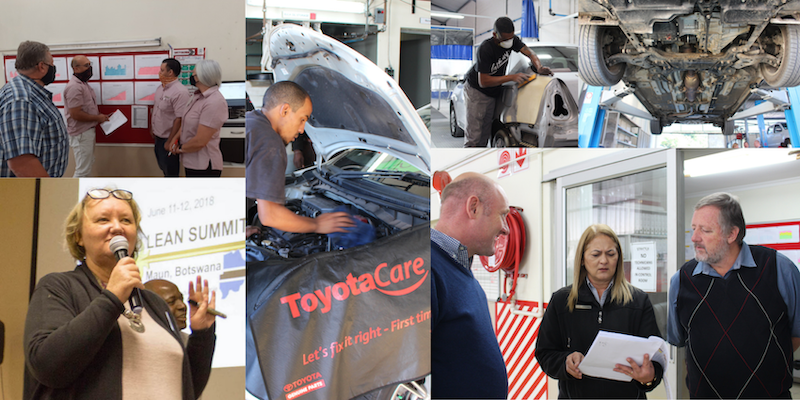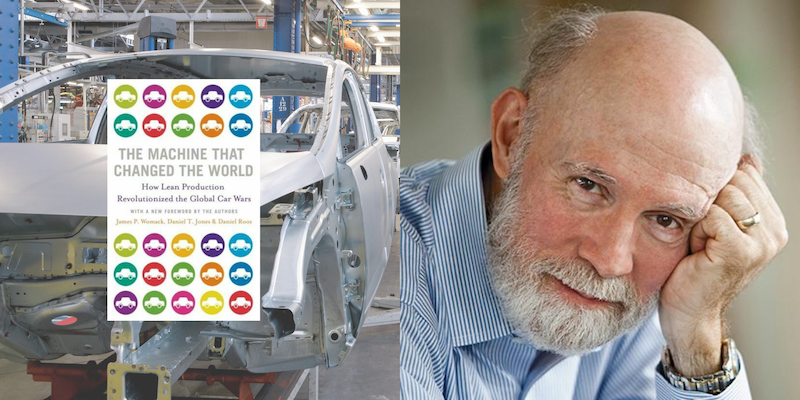
10 obstacles to a lean transformation
FEATURE – Hansei is a powerful tool that helps us understand Lean Thinking and advance on our journey. The author shares the lessons he learned from the struggles Halfway Toyota encountered during its years-long transformation.
Words: Terry O’Donoghue, Senior Advisor, Halfway Toyota
The lean journey of the Halfway Group has been documented extensively here on Planet Lean (read our articles here). By any measure, the transformation has been successful, but this does not mean that every initiative has been successful or even that every site has had success. In fact, there has been a lot of struggle and failure in our journey, and I think that’s where the biggest learning has come from.
In this article, I’d like to share the most important lessons that have stemmed from these struggles, hoping to answer some of the most common questions people ask when reflecting on Lean Thinking: what gets in the way of a transformation? What stops or hinders the implementation of lean? Why do we struggle to make it stick everywhere?
- MISALIGNMENT
Spending time building alignment around a shared objective – through dialogue, listening and engaging people – always pays off. Conversely, a lack of alignment will represent a significant anchor dragger for an organization’s lean implementation and, more in general, performance.
And where does the responsibility to develop alignment sit? Management, of course. Let’s use a sports analogy to clarify the point. Think of the French teams in the 2010 and 2018 FIFA World Cup competitions. The 2010 team in South Africa was packed with talented individuals, (including Evra and Henry) but their performance was dismal. They exited after round one amid controversy and conflict within the squad and between the squad and management. The 2018 team was no more talented as far as individual players go, but their performance in Russia was outstanding and they won the World Cup.
The purpose of the two teams was the same, and the talent available was similar. The structure or culture of French football could not have changed so much in eight years. But the performance was very different. Might that difference have come from the alignment, values and behaviors? Was the difference in the different coaches’ ability to get the best out of the squad by aligning all the players around the purpose and way they would play together to achieve the purpose? Sometimes the team’s ability is not sufficient, and the execution is poor. Sometimes the approach and style are inadequate to outperform the opposition. In 2010 it was the lack of cohesion and commitment. Some teams just don’t “click” (among themselves or with their leaders). If the coach can’t overcome this hurdle, they perhaps should accept that sometimes they are just not the right coaches for a certain team. Domenech wasn’t right for the 2010 team. Deschamps was right for the 2018 team. It showed first in the alignment and commitment and then in the results.
- REMUNERATION
An issue that we face time and again, usually at the very start of any new effort, is the way we pay our people. Measuring and remunerating people based on the individual performance of their functional silo focused on today’s transaction, is not the smartest way to get them to think about the horizontal flow of value to the customer. Yet, we do it all the time in the motor retail industry (and elsewhere, really). Great effort needs to be expended to change this approach, but once you do progress can be swift. Making clear the value to the customer and the value stream that creates it and then rewarding the employees involved in the stream as a team (sharing the rewards, all get or none get) when the performance reaches the goal moves the focus to collaboration around the flow of value to the customer.
- WRONG MEASURES AND METRICS
In the motor industry, ranking and outcome have become dominant and an end in themselves. It’s all about the score, as opposed to the fundamentals of the customer value of quality right first time on time and what it takes to ensure this is achieved. The staff become skilled at gaming the metrics to get a good score and the focus is lost on the real work. Easy to measure, but superficial criteria (like the company logo in the cappuccino foam) are used as a substitute instead of measuring the real work.
The way management interface with the work is also critical. Deming once said that too much of management behavior is about merely finding and recording the failures of men. The real role of leaders lies in removing the causes of failure and helping people do a better job with less effort, rather than exhorting them just to try harder.
How and where you look at metrics will determine whether you're merely recording failure or whether you're in a position to help people solve the problems that they face. Measures must reflect the state of the work, where it happens as it happens. This is much more useful to people focused on solving problems and delivering value than any monthly review of financially based information.
I have seen time and time again how the most common measurements in use in dealerships typically fail to provide a clear picture of the situation. Unless you revise the way you measure performance and review the work, your role as a manager will end up being a barrier to the transformation you seek. It comes down to how you view the role of the leader. Do you see the leader at the pinnacle of the traditional pyramid, where everything is set up to “report” by feeding information upwards so that the leader can decide, or do you see the leader as the foundation of an organization that is set up to support front-line workers who serve the customers?
- TOP EXEC SUPPORT
Enthusiastic commitment from senior leaders is helpful, but rare. Sometimes benign neglect is the best you can hope for and, truth is, you can go a long way with benign neglect. The enthusiasm for the lean transformation is often strongest among the front-line workers, who very seldom show resistance. Once the measures are aligned and a supportive environment established, their creativity is unleashed. And the results can be astounding.
The real impact of top execs’ support comes into play when the enthusiastic lean workers runs into resistance from their peers or someone above them in the hierarchy. The support they get from the boss then in overcoming that resistance will determine how far that transformation can go. Without support, the transformation will be limited to the part of the pyramid that the individual is responsible for.
People can only improve the work when they are granted authority to make the changes to align to the new thinking, but when this is the lacking a departmental head or even a team leader can still achieve a great deal within their own sphere of responsibility. It's the covert hostility that's fatal to transformation efforts.
- TURF WARS
This is probably the most sensitive area of a transformation. Call it resistance to change or politics, but this is all about a struggle for control. It's not uncommon for an approach that involves staff and makes problems visible to expose the insecurity of some managers, whose understanding of how things work is being challenged. Not everyone deals well with that and at Halfway some of the biggest difficulties we faced came down to this.
It requires a high-level intervention and the explicit expectations of the executive to overcome this hindrance, which can end up being fatal to an initiative. This is one area where I'm often forced back on the poorest of solutions: change the person. Remember that these difficulties get magnified when you use a lean team of experts to spread and implement the transformation: if you can't build lean into the work and responsibility of front-line people, you're going to come across more and more of these turf battles.
- BEWARE THE EXPEDITOR
Ohno once said: “Let the flow manage the process, don't let management manage the flow”. Much of what we have achieved at Halfway has been rooted in the relentless pursuit of flow. One-by-one processing drives the need to improve quality to a consistent standard and keeps any deviation clear and obvious, none of which is compatible with expediting. Here’s an example: the fitment operation at our largest dealership, in Johannesburg, was a source of frustration for customers and salespeople. It had dubious quality and alarming scrap rates and seldom finished vehicles at the promised time. In 2016, we were following a strategy of centralizing support operations like fitment to create a factory-like industrialization and free up space at the dealership for more retail work. When the site we had chosen became unavailable, we had to opt for one that was 29 kilometers away – too far for a sales manager, who was a compulsive expeditor, to interfere with the operation. The same team, with the same leader, were able to establish and protect the flow and, free from interference, the performance improved dramatically, and this operation is now the best of the model line examples we have. Remember: the more senior the expeditor, the bigger the danger to your operation.
- NOT KNOWING THE WORK
To take on a leadership role, you have to have knowledge of the work. You need to understand enough to be able to contribute to the design of the process and to ensure the unimpeded flow of value to the customer. If you don't, you have to be able to listen enough to the people who do understand the process, to work out how to apply principles to that knowledge and improve the work. It is always about the work.
- LACKING COURAGE
One of the most insidious effects of misaligned measures and inappropriate benchmarking is the fear they generate in top performers. Lean needs you to be brave. You need to have the confidence that a failed experiment is not fatal. More dangerous still is a situation in which the metrics you are relying on are not giving a valid reading of your situation (like superficial evaluations and the superficial response they generate, which are not rooted in quality and seem to follow the idea that if the client has not complained that must mean the work is good). This fear can result in stagnation. In time, the metrics will catch up with you and then you really won't be number one anymore.
- LACKING HUMILITY AND HONESTY
It goes hand in hand with the previous point. Lean needs a leader to be humble and to face up to the reality that things might not be as good as you thought they were. The purpose of visualization is to show things as they are and expose the problems.
Sharon Visser, who led the transformation in our largest Botswana operation in Maun, talks about the emotional demands of realizing how poor the performance was once the measures had been made visible. Once you have come to terms with facing the harsh reality, seeing things in a new light lays the foundation for the exciting work of solving the problems that have been exposed. Because she was able to be so honest about the start position, Sharon has excelled in leading a transformation that is now a model for the country and is spreading lean thinking and practice far beyond Halfway's operations in Botswana.
- NOT DOING THE DETAIL
Standardization is only standardization when it's done in detail and repeatable. This is the only way to make deviations obvious and to build quality into the work. Now, in retail, people are often not great at detail and, therefore, they typically struggle to ensure standards are explicit and protected. But we know this is the way to go. The now famous example of the Japanese men's relay team at the Rio Olympics, who focused on the hand over of the baton to eliminate waste and overcome the disadvantage they had on straight speed, is an indication of what can be achieved with limited resources. A 1.28 second improvement on 400 meters translates to about 15 meters at the speed they're running – a phenomenal difference, achieved by simply understanding the detail of the baton change. Make sure your people focus on the detail when writing their standards and that they write them in their own handwriting, at the workplace. That way they will be comfortable to change the standard when they find a better way of doing the work. Neatly typed and laminated (or even framed) standards are often a sign that improvement has stopped and that the standard has been frozen. Keep the authority and responsibility for writing and updating the standards with the people doing the work.
WHAT MAKES LEAN SUSTAINABLE?
Sustainability is the holy grail we're searching for. In fact, if it's a transformation, it means it's sustainable – otherwise, it's just an intervention that will last as long as the external energy lasts. Sustainability means to generate that energy from within.
In my experience, the people who are making the most progress, doing the most innovative and impactful things and trying the most creative experiments are those who have an obsession for lean and continuous improvement. You can't give people motivation. I have my doubts if you can even inspire it. It's a self-generated thing that comes from within, stimulated by success, but it is individual and particular to each person. The more obsessive they are about eliminating waste and improving the work, the further they go and the more impact they have. The Blues Brothers, Elwood and Jake, were on “A Mission from God”. Maybe that encapsulates the kind of attitude that provides the energy that drives sustainable Lean Thinking.
THE APPROACH WE FOLLOWED
At Halfway, we always start by looking at the work and trying to understand its mix. The objective is to get flow, which is only possible when the work is predictable. So, we separate predictable work from the unpredictable.
Once we achieve flow, the benefits are dramatic: that creates the conditions for people to want to carry on with their improvement efforts. You can later figure out how to make work that is currently unpredictable more predictable. After creating a separate stream for the predictable work, you can use lean tools to develop the standard work.
Once a standard is set and documented, the visualization of gaps can initiate the PDCA cycle. This forms the foundation for the development of the problem-solving capability of the team members. It's this problem-solving capability that will determine the long-term success of continuous improvement. Nothing sustainable is achieved by instructing team members to change to a better process or by showing them how to improve the process. Only by solving real problems do you build problem-solving capability. Struggling with a problem is where the learning and development happens.
Guiding people through the process of identifying the problem, analyzing the data, developing a hypothesis and then designing an experiment to test the hypothesis is the only way to help them learn in a way that helps them play the continuous improvement game. It's not about compliance and audit; it’s about the development of the skill of learning to see a gap and responding to it by working out how to prevent it from occurring again. You learn from your own struggle.
THE AUTHOR

Read more


FEATURE – If we see lean thinking as a paradigm, which we do, then we should be able to define a set of values this paradigm is built on. So, are there lean ethics? Michael Ballé identifies 10 undisputed lean values, plus one.


INTERVIEW – In this Q&A, the Chief of Transformation of oil and gas company TechnipFMC tells us about their experience implementing Lean Product and Process Development.


INTERVIEW – Thirty years ago, a book introduced lean thinking to the world, started a global movement and transformed business forever. Our editor caught up with one of the authors.


NOTES FROM THE (VIRTUAL) GEMBA – Throughout the lockdown, this car-selling business has never lost its focus on people development. The author learns how this approach is helping the firm make the most of the crisis.

